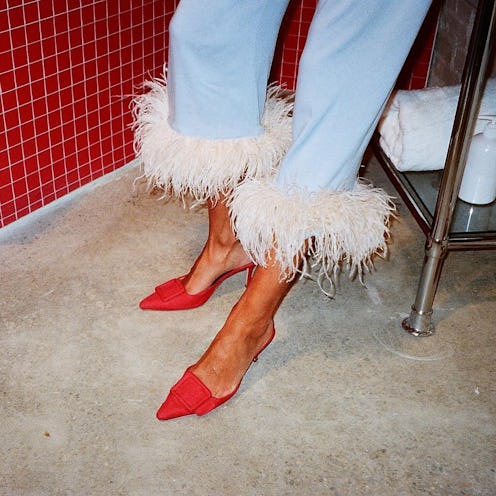As someone who recently transitioned to a freelance work life, it’s never been easier for me to stay in pajamas past noon on a Tuesday — but I don’t. To get my head out of sleep mode, I need coffee, a shower, mascara, and clothes that have buttons, zippers, and a minimal amount of lycra spandex (ie: no leggings). But there’s an exception to this rule, and it has everything to do with the pajamas fashion trend of 2018 that’s recently ubiquitous.
Perhaps you’ll remember Rihanna attending this year’s Met Gala after-party in Prada PJs, or a slew of Instagram influencers spotted in billowy, off-the-shoulder designs by Ukrainian brand Sleeper. Maybe you’re even familiar with the Leandra Medine-coined term “sleepleisure,” which encompasses the disregard for which clothing is meant to be public and which are private. Whatever the case, with so many examples of normalized pajama dressing, it begs the question as to whether this form of elevated, fashion-forward lounge attire is a trend— like Western silhouettes or bright colors that ebb and flow in popularity over years—or, like athleisure, is it a comfort-first aesthetic that’s in it for the long haul.
“Pjs are more than comfortable,” says Professor Carolyn Mair, PhD, founder of psychology.fashion, and originator and author of the Psychology of Fashion. Mair suggests that pajama jackets and wide-leg bottoms, in theory, aren’t so dissimilar from a tailored suit. “They might also be a lot more affordable than a pair of wide-legged silk trousers that are indistinguishable in terms of cut and style.”
For Mair, there is a logical connection between sleepwear and the prevailing appeal of athletic clothing. “Just as we loved the athleisure trend, which enabled us not to comprise being fashionable for comfort and functionality, PJs are doing the same.” However, according to Sleeper’s founders Asya Varetsa and Kate Zubarieva, the reason the look is so relevant has a lot to do with changed perceptions around occasion dressing, as well.
“So-called dress code becomes an atavism. Nowadays, people’s perception of style is solely based on their own ideas about beauty and convenience,” Zubarieva says. “The role of clothes in people’s lives have also changed. Relationships become less formal, people wear jeans to the theatre, and get married in pajamas. Life becomes much more comfortable.”
Zubarieva’s prediction makes sense if you take into account recent trends in the U.S. workplace. For example, according to a study by global freelancing website Upwork, it’s estimated that half the population will be freelance by the year 2027—that’s a lot of potential remote-working individuals for whom a typical office dress code does not apply.
That’s something Lili Chemla, owner of Liana, a brand that focuses on any-time-of-day sleepwear, as well as other loungewear pieces, keeps in mind as well. “Between tech advances and HR departments recognizing the benefits of workplace flexibility, I think the way a lot of us live our lives, and in particular our ‘work lives’, has changed in a lot of ways,” she says, adding that as a business owner, she’s even more conscious of the blurred lines between work and home. “I think that this change in lifestyle has definitely impacted the way people are dressing and shopping–championing comfort over formality.”
Of course, while this may suggest big changes in the future of business attire (that’s a whole separate story) it doesn’t quite clear up whether or not sleepwear — daytime nightgowns, silky sets for Friday night drinks, and statement coats replaced with robes — are a new normal. Spoiler alert: There are conflicted views.
Ask someone like James Bao, chief brand officer at sleepwear brand No Plans, and you’ll get an enthusiastic yes. “Sleepwear for everywhere is here to stay, “Bao says. One look at the label’s Instagram filled with models in effortless pastel sleep sets, posed playfully with takeout containers, and carry-on luggage — as though about to board an international flight — supports this idea. “This wave of bringing comfort to your everyday style signals an (anti) movement that celebrates the downtime, that post 9 to 5 when you’re at your realest — unbothered, uninhibited, and wonderfully imperfect.”
However, fashion psychologist Mair disagrees. “Wearing PJs in the daytime has been around for a few years by the few brave enough not to care about reactions (a bit like going out with your hair in rollers),” she explains. In her opinion, the sleepwear trend might be more of fashion statement than fashion staple, and possibly one whose popularity will rise and fall over time. “Fashion wouldn’t exist if trends lasted too long,” she adds.
While this may inevitably be true, when you look to so many inspiring brands in the space—both those listed above and more shopped out below — there’s certainly no indication that sleepwear will return strictly to the bedroom anytime soon. And even as someone who feels strongly about changing out of pajamas as soon as I’m untangled from bed in the morning, that’s not to say I won’t slip into another set before stepping out the door.
Below, shop a selection of some of the coolest brands making sleepwear that's not necessarily for sleeping.
